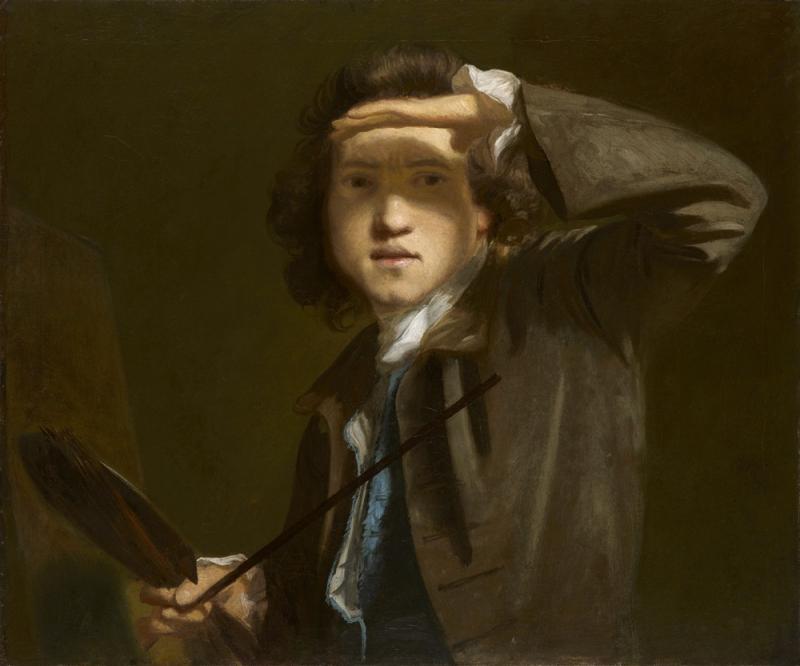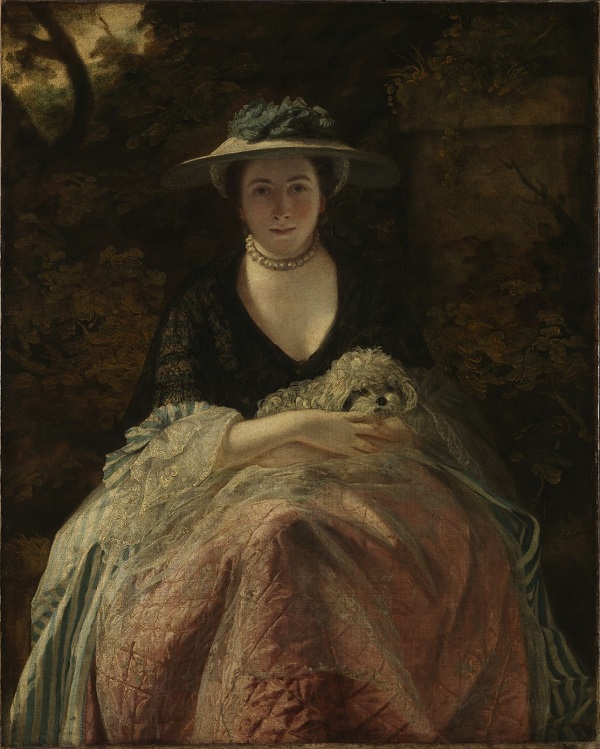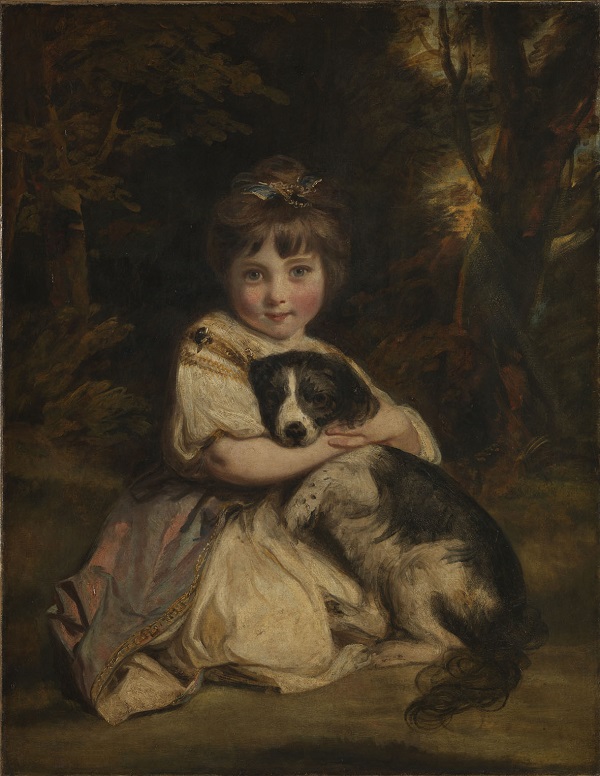Joshua Reynolds, Wallace Collection | reviews, news & interviews
Joshua Reynolds, Wallace Collection
Joshua Reynolds, Wallace Collection
The portraitist's experiments in paint buckle under the weight of too much information

The grand but domestic setting of Hertford House, home of the Wallace Collection, makes a fitting backdrop to an exhibition of paintings by Joshua Reynolds. The Marquesses of Hertford acquired some 25 paintings by Reynolds in the artist's lifetime, and after it, and the 12 that remain in the collection form the focus of this exhibition.
It is a little disappointing, then, to find oneself directed to the basement, which offers the single practical advantage of space – modest at that – and none of the charm of the 18th-century rooms upstairs. But this is not just a question of aesthetic sensibilities; with its yellow, uneven lighting the downstairs space only exacerbates the condition problems the exhibition serves to highlight.
The nature of these condition problems might seem a little surprising given Reynolds's reputation as a pillar of the establishment, but despite being the President of the Royal Academy and Principal Painter to the King, in his artistic practice he was a radical, experimenting with composition and the use of narrative elements in portraiture, and playing fast and loose with materials and techniques (main picture: Self-portrait, c1747-49). The results were often unsuccessful, and even in his own lifetime Reynolds’s paintings had a reputation for fading and have provided a conundrum for conservators ever since.
 Reluctant to carry out conservation work on paintings whose material composition was uncertain, the Wallace Collection joined forces with the National Gallery and the Paul Mellon Centre for Studies in British Art to launch the Reynolds Research Project, whose name, surely unwisely, echoes that of the much-maligned, and now defunct Rembrandt Research Project. But while the more famous RRP attempted to establish authorship, the Reynolds project has investigated the artist’s technique in order, primarily, to inform the cleaning of paintings apparently obscured by discoloured varnish.
Reluctant to carry out conservation work on paintings whose material composition was uncertain, the Wallace Collection joined forces with the National Gallery and the Paul Mellon Centre for Studies in British Art to launch the Reynolds Research Project, whose name, surely unwisely, echoes that of the much-maligned, and now defunct Rembrandt Research Project. But while the more famous RRP attempted to establish authorship, the Reynolds project has investigated the artist’s technique in order, primarily, to inform the cleaning of paintings apparently obscured by discoloured varnish.
While the project itself appears to have been fruitful and worthwhile, the resulting exhibition is bewilderingly uninformative, with snippets of technical information serving only to distract from and undermine the paintings themselves. From texts so extensive that they compete for wallspace with the paintings, we learn that Reynolds’s experiments with unorthodox mixtures of pigments and binding media have caused many of his pictures to darken and fade. But while it is pointed out more than once that his choice of red lake pigments, favoured for their translucent qualities but prone to fading, has caused a loss of brightness in draperies and the whitening of skin tones, the only other specific example that is given is an instance of cracking caused by the presence of varnish in the paint mixture.
This is a problem, because having been primed with the information that these paintings are not altogether as they should be, we need to know precisely what is wrong. Oddly enough, this seems most pressing when looking at Reynolds’s treatment of foliage, which appears in the background of a number of his pictures and is often so dark as to be almost illegible, as in the very fragile painting of St John the Baptist, after 1776. Equally however, there are examples of bright, fresh greenery, nowhere more so than in the monumental portrait of Mrs Elizabeth Carnac, 1775-6.
While it is easy to imagine that some paintings have succumbed to time and poor use of materials, while others have simply fared better, the truth is inevitably less straightforward. Reynolds’s attempts to emulate Old Master paintings, which in an era before the routine cleaning of pictures were often much darker than they are today, led him to deliberately knock back some areas of colour. In his celebrated portrait of Miss Nelly O’Brien, 1762-3 (pictured above left), Reynolds toned down areas of foliage by overlaying areas of yellow and green with dark glazes and varnish. The painting is an exploration of the effects of light and shade, and the striking contrast between Nelly’s luminous skin, bright, multi-textured draperies and the shady woodland setting is surely a carefully calculated extension of the painting’s central theme. The trouble is, that with a head full of darkening paint, it is just as easy to read the muted background as an area of loss.
 And to what should we ascribe the relatively bright background of Miss Jane Bowles, 1775-6 (pictured right), a painting that seems to have borne the ravages of time remarkably well, perhaps because it was made for a patron nervous about Reynolds’s reputation for fading painting? Like the portrait of Nelly O’Brien, the little girl with her dog has received conservation treatment as part of the current research project, but because we are never told exactly what has been done, there is a nagging uncertainty about what we are looking at. And if its pristine appearance did not make you suspect it, you would only find out from the catalogue that Mrs Elizabeth Carnac, has also recently been cleaned.
And to what should we ascribe the relatively bright background of Miss Jane Bowles, 1775-6 (pictured right), a painting that seems to have borne the ravages of time remarkably well, perhaps because it was made for a patron nervous about Reynolds’s reputation for fading painting? Like the portrait of Nelly O’Brien, the little girl with her dog has received conservation treatment as part of the current research project, but because we are never told exactly what has been done, there is a nagging uncertainty about what we are looking at. And if its pristine appearance did not make you suspect it, you would only find out from the catalogue that Mrs Elizabeth Carnac, has also recently been cleaned.
In fact, for an exhibition centred around the insights provided by technical examinations and conservation treatments, the curators are surprisingly coy about the particulars. We are told that conservation work done on Miss Nelly O’Brien has revealed “Reynolds’s great skill in rendering the different tones, textures and delicate colour harmonies of the sitter”, but not how this has been achieved. The answer, presumably, is by the removal of varnish using solvents, a process that seems so banal, low-tech and wide-open to blunders that it perhaps seemed expedient to let the public conjure up some imaginary laboratory procedure, reassuringly safe from human error.
The use of science as a comfort blanket is depressingly familiar territory, and while a smattering of x-ray and infra-red photographs serve as signifiers that “science has been done”, their small scale means they amount to little more than window dressing. The aspects of Reynolds's working process that they claim to elucidate distract from the opportunities to look first hand at paint-handling and composition, and, uniquely, to compare the two portraits of Nelly O'Brien, brought together here for the first time since they were made. Other aspects of Reynolds's practice that could very effectively be explored in an exhibition, like his habit of producing a study alongside a painting so that he could test out ideas before committing them to the final version, are given only fleeting attention.
While a bigger exhibition might have allowed the paintings more space, with opportunities to explain by example, thus reducing the need for extended wall texts, the concept behind it is surely fundamentally flawed. By focusing on what we cannot see, or aren't supposed to see, it is easy to lose sight of a painting altogether.
Explore topics
Share this article
The future of Arts Journalism
You can stop theartsdesk.com closing!
We urgently need financing to survive. Our fundraising drive has thus far raised £49,000 but we need to reach £100,000 or we will be forced to close. Please contribute here: https://gofund.me/c3f6033d
And if you can forward this information to anyone who might assist, we’d be grateful.

Subscribe to theartsdesk.com
Thank you for continuing to read our work on theartsdesk.com. For unlimited access to every article in its entirety, including our archive of more than 15,000 pieces, we're asking for £5 per month or £40 per year. We feel it's a very good deal, and hope you do too.
To take a subscription now simply click here.
And if you're looking for that extra gift for a friend or family member, why not treat them to a theartsdesk.com gift subscription?
more Visual arts
 'We are bowled over!' Thank you for your messages of love and support
Much-appreciated words of commendation from readers and the cultural community
'We are bowled over!' Thank you for your messages of love and support
Much-appreciated words of commendation from readers and the cultural community
 Sir Brian Clarke (1953-2025) - a personal tribute
Remembering an artist with a gift for the transcendent
Sir Brian Clarke (1953-2025) - a personal tribute
Remembering an artist with a gift for the transcendent
 Emily Kam Kngwarray, Tate Modern review - glimpses of another world
Pictures that are an affirmation of belonging
Emily Kam Kngwarray, Tate Modern review - glimpses of another world
Pictures that are an affirmation of belonging
 Kiefer / Van Gogh, Royal Academy review - a pairing of opposites
Small scale intensity meets large scale melodrama
Kiefer / Van Gogh, Royal Academy review - a pairing of opposites
Small scale intensity meets large scale melodrama
 Jenny Saville: The Anatomy of Painting, National Portrait Gallery review - a protégé losing her way
A brilliant painter in search of a worthwhile subject
Jenny Saville: The Anatomy of Painting, National Portrait Gallery review - a protégé losing her way
A brilliant painter in search of a worthwhile subject
 Abstract Erotic, Courtauld Gallery review - sculpture that is sensuous, funny and subversive
Testing the boundaries of good taste, and winning
Abstract Erotic, Courtauld Gallery review - sculpture that is sensuous, funny and subversive
Testing the boundaries of good taste, and winning
 Edward Burra, Tate Britain review - watercolour made mainstream
Social satire with a nasty bite
Edward Burra, Tate Britain review - watercolour made mainstream
Social satire with a nasty bite
 Ithell Colquhoun, Tate Britain review - revelations of a weird and wonderful world
Emanations from the unconscious
Ithell Colquhoun, Tate Britain review - revelations of a weird and wonderful world
Emanations from the unconscious
 Rachel Jones: Gated Canyons, Dulwich Picture Gallery review - teeth with a real bite
Mouths have never looked so good
Rachel Jones: Gated Canyons, Dulwich Picture Gallery review - teeth with a real bite
Mouths have never looked so good
 Yoshitomo Nara, Hayward Gallery review - sickeningly cute kids
How to make millions out of kitsch
Yoshitomo Nara, Hayward Gallery review - sickeningly cute kids
How to make millions out of kitsch
 Hamad Butt: Apprehensions, Whitechapel Gallery review - cool, calm and potentially lethal
The YBA who didn’t have time to become a household name
Hamad Butt: Apprehensions, Whitechapel Gallery review - cool, calm and potentially lethal
The YBA who didn’t have time to become a household name

Add comment